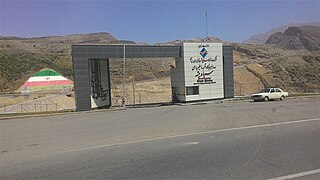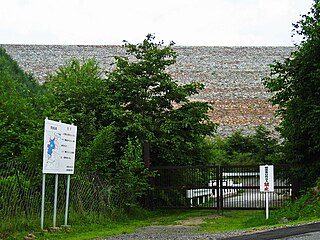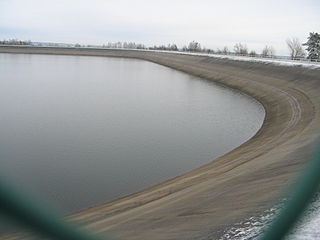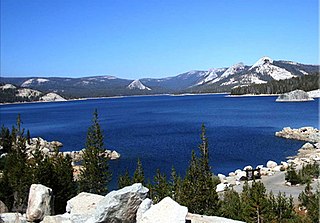
Pumped-storage hydroelectricity (PSH), or pumped hydroelectric energy storage (PHES), is a type of hydroelectric energy storage used by electric power systems for load balancing. The method stores energy in the form of gravitational potential energy of water, pumped from a lower elevation reservoir to a higher elevation. Low-cost surplus off-peak electric power is typically used to run the pumps. During periods of high electrical demand, the stored water is released through turbines to produce electric power. Although the losses of the pumping process make the plant a net consumer of energy overall, the system increases revenue by selling more electricity during periods of peak demand, when electricity prices are highest. If the upper lake collects significant rainfall or is fed by a river then the plant may be a net energy producer in the manner of a traditional hydroelectric plant.

The Robert Moses Niagara Hydroelectric Power Station is a hydroelectric power station in Lewiston, New York, near Niagara Falls. Owned and operated by the New York Power Authority (NYPA), the plant diverts water from the Niagara River above Niagara Falls and returns the water into the lower portion of the river near Lake Ontario. It uses 13 generators at an installed capacity of 2,525 MW (3,386,000 hp).
The Ingula Pumped Storage Scheme is a pumped-storage power station in the escarpment of the Little Drakensberg range straddling the border of the KwaZulu-Natal and Free State provinces, South Africa. It is about 22 km (14 mi) North-East of Van Reenen.

The Goldisthal Pumped Storage Station is a pumped-storage power station in the Thueringer Mountains at the upper run of the river Schwarza in Goldisthal, Germany. It was constructed between 1997 and 2004. It has an installed capacity of 1,060 megawatts (1,420,000 hp), the largest hydroelectric power plant in Germany and one of largest in Europe.

The Siah Bisheh Pumped Storage Power Plant, also spelled Siyāhbisheh and Siah Bishe, is located in the Alborz Mountain range near the village of Siah Bisheh and 48 km (30 mi) south of Chalus in Mazandaran Province, Iran. The power plant uses the pumped-storage hydroelectric method to generate electricity during periods of high energy demand, making it a peaking power plant, intended to fulfill peak electricity demand in Tehran 60 km (37 mi) to the south. When complete it will have an installed generating capacity of 1,040 megawatts (1,390,000 hp) and a pumping capacity of 940 megawatts (1,260,000 hp). Planning for the project began in the 1970s and construction began in 1985. It was delayed from 1992 until 2001 and the first generator went online in May 2013. The remaining generators were commissioned by 1 September 2015. The power plant is the first pumped-storage type in Iran and will also use the country's first concrete-face rock-fill dam – two of them.
The Yangyang Pumped Storage Power Station uses the water of the Namdae-Chun River to operate a 1,000-megawatt (1,300,000 hp) pumped storage hydroelectric power scheme, about 10 kilometres (6.2 mi) west of Yangyang in Gangwon Province, South Korea. The lower reservoir is created by the Yangyang Dam on the Namdae and the upper reservoir by the Inje Dam is located 937 metres (3,074 ft) above the power plant. Construction on the power plant began in 1996 and it was completed and dedicated on September 13, 2006. It is operated by Korean Midland Power Co., a subsidiary of Korea Electric Power Company and was completed at a cost of ₩1.1 trillion won. The first generator was operational on February 23, 2006 and the last August 10, 2006.

The Dniester Pumped Storage Power Station is a pumped storage hydroelectric scheme that uses the Dniester River 8 kilometres (5.0 mi) northeast of Sokyriany in Chernivtsi Oblast, Ukraine. Currently, four of seven 324-megawatt (434,000 hp) generators are operational and when complete in 2028, the power station will have an installed capacity of 2,268 megawatts (3,041,000 hp).

The Kazunogawa Pumped Storage Power Station is a pumped-storage hydroelectric power station near Kōshū in Yamanashi Prefecture, Japan. The station is designed to have an installed capacity of 1,600 megawatts (2,100,000 hp) and three of the four 400 megawatts (540,000 hp) generators are currently operational, for a total operational capacity of 1200 MW. Construction on the power station began in 1993 and the first generator was commissioned on 3 December 1999. The second was commissioned on 8 June 2000. The third one became operational on 9 June 2014, six year early due to post-power demand from the Great East Japan earthquake. The fourth and final generator is slated to be commissioned by 2024. It is owned by TEPCO and was constructed at a cost of US$2.2 billion.
The Bailianhe Pumped Storage Power Station is a pumped-storage hydroelectric power station located 58 kilometres (36 mi) east of Huanggang in Hubei Province, China. It was constructed between 2004 and 2010 and has a 1,200 megawatts (1,600,000 hp) installed capacity. The power station operates by shifting water between an upper and lower reservoir to generate electricity. For this project, only the upper reservoir had to be created as an existing reservoir, the Bailianhe Reservoir, was used as the lower. During periods of low energy demand, such as at night, water is pumped from Bailianhe Reservoir up to the upper reservoir. When energy demand is high, the water is released back down to the lower reservoir but the pump turbines that pumped the water up now reverse mode and serve as generators to produce electricity. The process is repeated as necessary and the plant serves as a peaking power plant.

The Coo-Trois-Ponts Hydroelectric Power Station is a pumped-storage hydroelectric power station located in Trois-Ponts, Province of Liege, Belgium. Located next to the Amblève River, one of the few sites where 250+ meter local elevation can be found in Belgium. The power station uses its water to support a power scheme where water is pumped from a lower reservoir to one of two upper reservoirs known as Coo I and Coo II. When energy demand is high, water can be released from these reservoirs for power generation. The water then returns to the lower reservoir and the process repeats as needed. The same machines that pump the water to the upper reservoirs at a higher elevation are also used as generators. The plant was commissioned in two stages, Coo I (1969) and Coo II (1978). It is owned by Engie-Electrabel and has an installed capacity of 1,164 MW.

The Grand'Maison Dam is an embankment dam on L'Eau d'Olle, a tributary of the Romanche River. It is located in Vaujany of Isère within the French Alps. The primary purpose of the dam is to serve as the upper reservoir for a pumped-storage hydroelectric scheme where Lac du Verney located lower in the valley is the lower reservoir. The dam was constructed between 1978 and 1985 with its power station being commissioned in 1987. With an installed capacity of 1,800 MW, it is the largest hydroelectric power station in France.

The Helms Pumped Storage Plant is located 50 mi (80 km) east of Fresno, California in the Sierra Nevada Mountain Range's Sierra National Forest. It is a power station that uses Helms Creek canyon on the North Fork of the Kings River for off-river water storage and the pumped-storage hydroelectric method to generate electricity. After being planned in the early 1970s, construction on the plant began in June 1977 and commercial operations began on 30 June 1984. It has an installed capacity of 1,212 MW and is owned by Pacific Gas and Electric Company.

The Liyang Pumped Storage Power Station is a pumped-storage hydroelectric power station 22 km (14 mi) south of Liyang in Jiangsu Province, eastern China. Preliminary construction began in 2002 and major works started in May 2011. The first unit of the power station was commissioned in 2017, the power station will have an installed capacity of 1,500 MW.

The Edolo Pumped Storage Plant is located along the Oglio River just downstream of Edolo, Brescia Province in the Lombardy region of Italy. Using the pumped-storage hydroelectric method, it has an installed capacity of 1,000 megawatts (1,300,000 hp). Its generators were commissioned between April 1984 and November 1985. Lake Avio was previously completed in 1929 and Lake Benedetto completed in 1940.
The Presenzano Hydroelectric Plant, officially known as the Domenico Cimarosa Hydroelectric Plant, is located along the Volturno River in Presenzano, Province of Caserta, Italy. Using the pumped-storage hydroelectric method, it has an installed capacity of 1,000 megawatts (1,300,000 hp). Construction began in 1979, it was finished in 1990 and the generators commissioned in 1991. In 2004, the plant was renamed after Domenico Cimarosa. Power is generated by releasing water from the upper Cesima reservoir down to the power plant which contains four reversible 250 MW Francis pump-turbine-generators. After power production, the water is sent to the lower reservoir. During periods of low energy demand, the same pump-generators pump water from the lower reservoir back to the upper where it becomes stored energy. Power generation occurs when energy demand is high. The upper reservoir, formed by an embankment dam, is located at an elevation of 643 metres (2,110 ft) in the municipality of Sesto Campano in the Province of Isernia. Both the upper and lower reservoirs have an active storage capacity of 6,000,000 cubic metres (4,900 acre⋅ft). The difference in elevation between both the upper and lower affords a hydraulic head of 495 metres (1,624 ft).
The Upper Cisokan Pumped Storage Plant is a proposed pumped-storage hydropower facility in Indonesia, due for completion by 2025.

The Vianden Pumped Storage Plant is located just north of Vianden in Diekirch District, Luxembourg. The power plant uses the pumped-storage hydroelectric method to generate electricity and serves as a peaking power plant. Its lower reservoir is located on the Our River, bordering Germany, and the upper is elevated above on the nearby Saint Nicholas Mountain. Construction on the plant began in 1959 and the first pump-generators were commissioned in 1962. A tenth pump-generator was installed in 1976 bringing the plant's installed generating capacity to 1,096 megawatts (1,470,000 hp). The plant generates an average of 1,650 gigawatt-hours (5,900 TJ) annually but of course consumes even more. Generally the efficiency of this energy storage method is around 70–80%. The plant is owned by Société électrique de l'Our and RWE. Construction on an eleventh pump-generator began in 2010 and it is expected to be commissioned in 2013, which will bring the plant's installed capacity to 1,296 megawatts (1,738,000 hp).

The Kyiv Pumped-Storage Power Plant is a pumped-storage power station on the west bank of the Kyiv Reservoir in Vyshhorod, Ukraine. The Kyiv Reservoir serves as the lower reservoir and the upper reservoir is located 70 m (230 ft) above the lower. Water sent from the upper reservoir generates electricity with three 33.3 megawatts (44,700 hp) conventional hydroelectric generators and three 45 megawatts (60,000 hp) reversible pump generators. During periods of low demand, such as nighttime, the pump generators push water from the lower reservoir to the upper for use during peak hours. The first generator was commissioned in 1970, and the last in 1972.

Ghatghar Dam refers to two associated gravity dams built using roller-compacted concrete, the first use in India. They are situated in Ghatghar village in Ahmednagar district Maharashtra, India. Both dams create a lower and upper reservoir for the 250 MW pumped-storage hydroelectric power station. The upper Ghatghar dam is 15 m (49 ft) tall and on the Pravara River, a tributary of Godavari river. The lower Ghatghar dam is 86 m (282 ft) tall and located on the Shahi Nalla which is a tributary of Ulhas River to the south west of the upper reservoir in a steep valley. The hydro power project diverts Godavari river basin water outside the basin area to a west flowing river of Western ghats.

The Nant de Drance Hydropower Plant is a pumped-storage power station in the canton of Valais in Switzerland. It is within the municipality of Finhaut, district of Saint-Maurice and about 14 km (8.7 mi) southwest of Martigny. Construction on the power plant began in 2008 and it began operations in 2022. It is owned by Nant de Drance SA, a consortium of Alpiq (39%), SBB (36%), Industrielle Werke Basel (15%) and Forces Motrices Valaisannes (FMV) (10%). The US$1.9 billion plant has installed capacity of 900 MW and an energy storage capacity of 20 GWh.
















